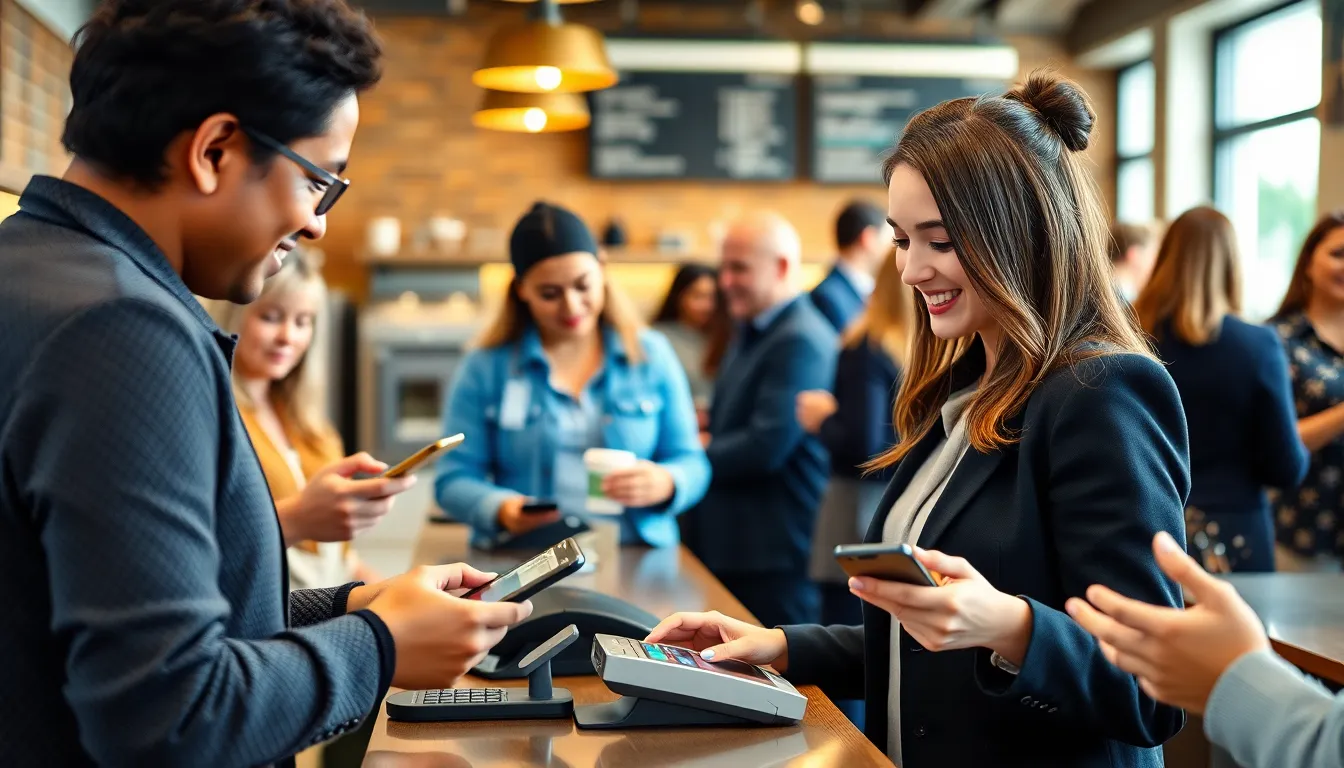In a world where waiting in line feels like a form of medieval torture, contactless payments swoop in like a superhero, saving both time and sanity. Gone are the days of fumbling for cash or searching for that elusive credit card buried deep in a wallet. With just a tap or a wave, transactions happen faster than you can say “I’ll take that latte to go!”
Imagine strolling through your favorite café, ordering your drink, and paying without breaking a sweat. Contactless payments not only streamline the checkout process but also add a dash of modern flair to everyday transactions. It’s like having a magic wand that turns your phone into a wallet. So, why not embrace the future? Let’s dive into the world of contactless payments and discover how this nifty tech is transforming the way people spend money.
Table of Contents
ToggleOverview Of Contactless Payments
Contactless payments streamline transactions, offering convenience without the need for physical contact. By utilizing radio frequency identification or near field communication technology, users experience faster payment processing.
Definition And Technology Behind It
Contactless payments refer to transactions completed by tapping or waving a card, smartphone, or wearable device near a payment terminal. This technology uses radio frequency identification (RFID) and near field communication (NFC) to securely transmit data. RFID enables communications within a short range, while NFC facilitates two-way transactions between devices. Both technologies make it possible to validate and authorize payments swiftly, enhancing the user experience.
Types Of Contactless Payments
Several types of contactless payment methods exist in today’s market. Mobile wallets, like Apple Pay and Google Pay, allow users to store card information on smartphones for seamless transactions. Contactless credit and debit cards contain embedded chips, enabling a quick tap at compatible points of sale. Wearable devices, such as smartwatches and fitness trackers, also support payment functionalities. Each type offers unique benefits, catering to various preferences and scenarios for users.
Benefits Of Contactless Payments
Contactless payments offer remarkable advantages that enhance the transaction experience. These methods prioritize user convenience and security.
Convenience And Speed
Transactions using contactless payments occur swiftly, minimizing wait times at checkout. A simple tap or wave near a payment terminal completes purchases in seconds. Busy individuals appreciate this instant processing, especially during morning rushes at coffee shops. Additionally, customers no longer need to fumble for cash or cards, resulting in smoother interactions. Many retailers now adapt to contactless technologies, providing easy access to modern payment methods for their customers.
Enhanced Security Features
Security features in contactless payments significantly reduce the risk of fraud. These transactions use encryption tech that protects sensitive info during transfers. Each transaction features a unique code that prevents replication, making it difficult for unauthorized users to compromise financial data. Moreover, many contactless systems require users to authenticate through biometric verification or passcodes for added protection. Businesses also benefit from reduced chargebacks and fraud-related losses, making contactless payments a win-win for consumers and merchants alike.
Challenges And Limitations
Despite their advantages, contactless payments face several challenges and limitations. Users may encounter barriers that slow down adoption rates in certain demographics.
Adoption Barriers
Resistance often arises from consumers unfamiliar with the technology. Some individuals prefer traditional payment methods, fearing that contactless options may be complicated. Additionally, a lack of understanding about security features can hinder widespread acceptance. Merchants may face obstacles too; without appropriate infrastructure, small businesses struggle to implement contactless systems. Economic constraints further limit the ability to invest in new technologies. These barriers create a gap between the efficiency of contactless payments and their usability in everyday transactions.
Potential Security Concerns
Concerns about data security accompany the rise of contactless payments. Some users worry about the possibility of unauthorized charges. Such apprehensions stem from the perception that contactless technology makes transactions vulnerable to hackers. Despite encryption and tokenization strategies in place, skepticism remains present among consumers. Fraudulent activities can occur if devices are compromised, leading to greater caution when using contactless methods. Merchants must proactively address these concerns to foster trust and encourage adoption for a broader user base.
Future Of Contactless Payments
Contactless payments continue to evolve, shaping the landscape of financial transactions. Emerging technologies and consumer preferences drive innovations in this sector.
Trends And Innovations
Cryptocurrency integration becomes increasingly relevant in the contactless payment landscape. Adoptions of blockchain technology provide secure, transparent transactions. Voice-activated payments through smart devices offer convenience and hands-free options. Increased collaboration between fintech companies and traditional banks enhances service offerings. Wearable technology expands contactless payment capabilities with smartwatches and fitness bands. Enhanced biometric authentication, such as facial recognition and fingerprint scanning, strengthens security measures. Instant payment solutions emerge, facilitating real-time transactions across various platforms.
Impact On Consumers And Retailers
Consumers enjoy speed and convenience with contactless payment methods. Shorter transaction times lead to improved experiences at checkout. Retailers benefit from increased sales through faster processing and shorter lines. Consumer preference for contactless options drives retail adaptations, with many businesses adopting the technology. Enhanced security features reduce the risk of fraud, instilling confidence in users. Adoption also leads to cost savings for merchants through lower transactional fees. Overall, the future promises a seamless transaction experience for both consumers and retailers as contactless payments gain traction.
Conclusion
Contactless payments are reshaping the financial landscape by offering unparalleled convenience and speed. As more consumers and merchants embrace this technology the potential for a frictionless transaction experience grows. The advantages of quick checkouts and enhanced security features make it an appealing choice for busy individuals.
While challenges remain in terms of adoption and consumer trust it’s clear that the future of contactless payments is bright. Innovations in technology will continue to drive this trend forward making transactions not only easier but also safer. As society moves toward a more digital economy contactless payments will undoubtedly play a pivotal role in how people manage their finances.





